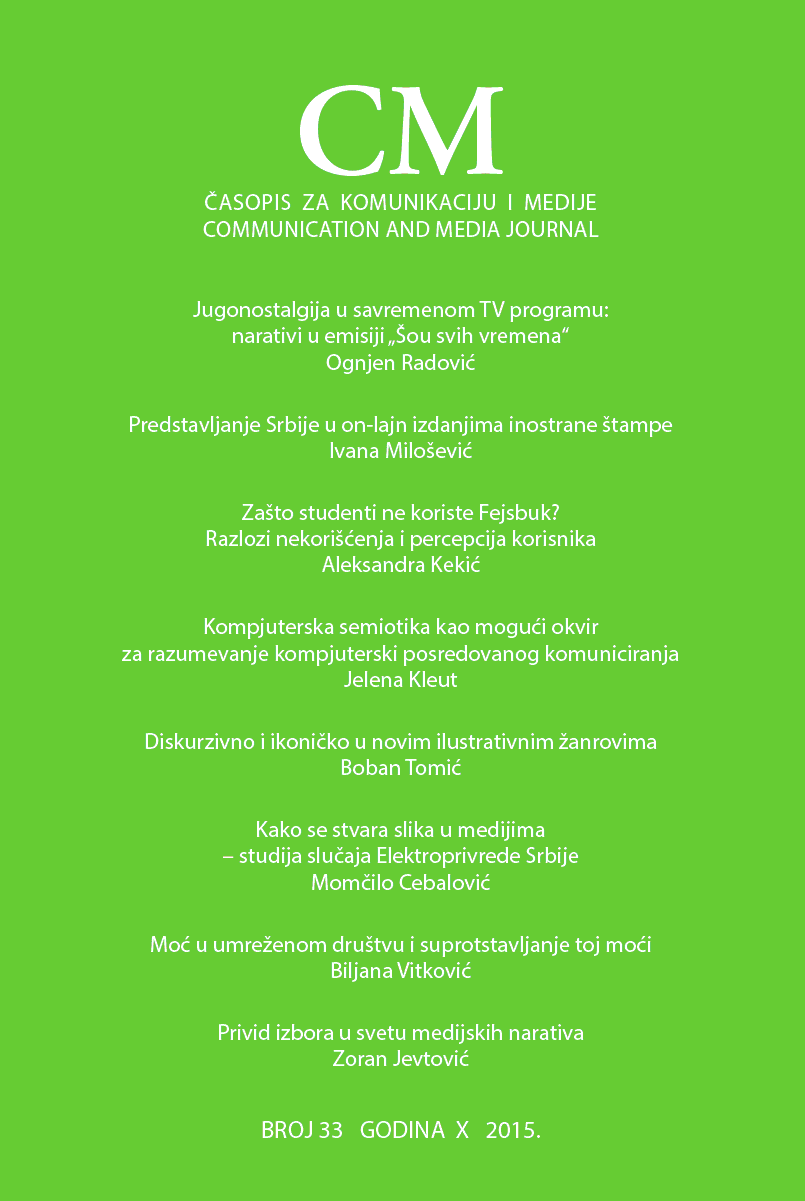Representation of Serbia in foreign press online
Abstract
This paper presents the results of the treatment of Serbia on German, American, British and French websites during the period of January to March 2013. A quarterly quantitative and qualitative content analysis showed that 12 internet websites have had 644 news items about the situation in Serbia. Apart from the number of news items, the tone of the reports was also examined and it was found to be overwhelmingly neutral. The results obtained demonstrate that sports manifestations were most often covered events, thus making Novak Đoković the most frequently mentioned Serbian person on the select websites.
It has been over 100 years since the first research pertaining to Serbia’s treatment in the foreign media. The starting hypothesis that reporting on Serbia has changed was partially confirmed. One might come under the impression that even though war years and sanctions are behind Serbia, journalists still mention Yugoslavia, Slobodan Milošević, Ratko Mladić, wars and poverty every time this is in their favour. Usage of verbal stereotypes has been noticed, while Serbs have been represented as warlike people, nationalists, sometimes with the addition of “extreme”. The image of Serbia is different that it had been 100 years ago, but not enough to prove the starting hypothesis.
References
Bakić, J. (1999). Stereotipi o Srbija u javnostima pojedinih zapadnih nacija. Nova srpska politička misao, VII (1-2): 27–55. Posećeno 5. 2. 2015. URL:
http://www.komunikacija.org.rs/komunikacija/casopisi/nspm/1-2/d003/html_ser_lat
Bakić-Hayden, M. (2006). Varijacije na temu „Balkan“. Beograd: Institut za filozofiju i društvenu teoriju - Filip Višnjić.
Begenišić. Lj. (2013). Postali smo dobri preko noći. Večernje novosti, 2. jun 2013, str. 4.
Branković, S. (2009). Metodi iskustvenog istraživanja društvenih pojava. Beograd: Megatrend univerzitet.
Brigs, A. i Kobli, P. (2005). Uvod u studije medija. Beograd: Clio.
Ćurgus-Kazimir, V. (2003). Brušenje pameti. Beograd: Medijska dokumentacija.
Orvel, Dž. (1984). Tisuću devetsto osamdeset četvrta, Zagreb: August Cesarec.
Đerić, G. (2005). Pr(a)vo lice množine, Kolektivno samopoimanje i predstavljanje, mitovi, karakteri, mentalne mape i stereotipi. Beograd: Institut za filozofiju i društvenu teoriju - I.P. „Filip Višnjić“.
Džajls, D. (2010). Psihologija medija. Beograd: Clio.
Fajgelj, S. (2004). Metode istraživanja ponašanja. Beograd: Centar za primenjenu psihologiju.
Gidens, E. (2003). Sociologija. Beograd. Ekonomski fakultet.
Glišović, Lj. (2011). Srbija u ogledalu nemačke štampe 1978-2006. Beograd: Službeni glasnik.
Goldsvorti, V. (2000). Izmišljanje Ruritanije. Beograd: Čigoja štampa.
Hall, S. (1997). Representation: Cultural Representations and Signifying Practices. London: Sage Publications ltd.
Ivanović, Ž. (1995). Medijski rat protiv Srbije. Beograd: Tanjug.
Kesić, O. (1995). Srbija mora umreti. U Medijski rat protiv Srbije. Beograd: Tanjug.
Lamza Posevac, V. (2006). Metode istraživanja u novinarstvu. Zagreb: Fakultet političkih znanosti.
Lojd, D. (2004). Šta mediji rade našoj politici. Beograd: Samizdat B 92.
Lorimer, R. (1998). Masovne komunikacije. Beograd: Clio.
Milivojević, S. (2004). Žene i mediji: Strategije isključivanja. Genero: časopis za feminističku teoriju, posebno izdanje, 15–29.
Ninković Slavnić D. (2011). Medijska reprezentacija grupnih identiteta. CM: Časopis za upravljanje komuniciranjem, 6(11): 15–38.
Radojković, M. i Miletić, M. (2008). Komuniciranje, mediji i društvo. Beograd: Učiteljski fakultet.
Ristović, M. (2003). Crni Petar i balkanski razbojnici. Beograd: Udruženje za društvenu istoriju.
Rus-Mol, Š. (2005). Novinarstvo. Beograd: Clio.
Selesković, M. (1996). Srbija u nemačkom javnom mnjenju 1914-1918. Beograd: Izdavačko preduzeće „Rad“.
Spasić, I. (2008). Promene u Srbiji u perspektivi socijalnog učenja: retrospektiva jedne ideje. Filozofija i društvo, 3(37): 89–108.
Stojković, B. (2002). Identitet i komunikacija. Beograd: Fakultet političkih nauka.
Todorova, M. (2006). Imaginarni Balkan. Beograd: Biblioteka XX vek.
Tomić, Z. (2009). News age. Beograd: Službeni glasnik - Čigoja štampa.
Valić Nedeljković, D. (2003). Stereotipi u medijima. Posećeno 17. 2. 2015. URL: http://www.mc.rs/code/navigate.aspx?Id=1143.
Vuković, S. (2007). Kako su nas voleli, antisrpska propaganda i razbijanje Jugoslavije. Novi Sad: Stilos.
Vuković, S. (2009). Etika zapadnih medija: antisrpska propaganda devedesetih godina XX veka. Novi Sad: Izdavačka knjižarnica Zorana Stojanovića Sremski Karlovci.
Copyright
Authors retain copyright of the published papers and grant to the publisher the non-exclusive right to publish the article, to be cited as its original publisher in case of reuse, and to distribute it in all forms and media.
Licensing
The published articles will be distributed under the Creative Commons Attribution ShareAlike 4.0 International license (CC BY-SA). It is allowed to copy and redistribute the material in any medium or format, and remix, transform, and build upon it for any purpose, even commercially, as long as appropriate credit is given to the original author(s), a link to the license is provided, it is indicated if changes were made and the new work is distributed under the same license as the original.
Users are required to provide full bibliographic description of the original publication (authors, article title, journal title, volume, issue, pages), as well as its DOI code. In electronic publishing, users are also required to link the content with both the original article published in CM: Communication and Media and the licence used.
Authors are able to enter into separate, additional contractual arrangements for the non-exclusive distribution of the journal's published version of the work (e.g., post it to an institutional repository or publish it in a book), with an acknowledgement of its initial publication in this journal.
Self-archiving policy
Authors are permitted to deposit author’s publisher's version (PDF) of their work in an institutional repository, subject-based repository, author's personal website (including social networking sites, such as ResearchGate, Academia.edu, etc.), at any time after publication.
Full bibliographic information (authors, article title, journal title, volume, issue, pages) about the original publication must be provided and links must be made to the article's DOI and the license.
Disclaimer
The views expressed in the published works do not express the views of the Editors and the Editorial Staff. The authors take legal and moral responsibility for the ideas expressed in the articles. Publisher shall have no liability in the event of issuance of any claims for damages. The Publisher will not be held legally responsible should there be any claims for compensation.

